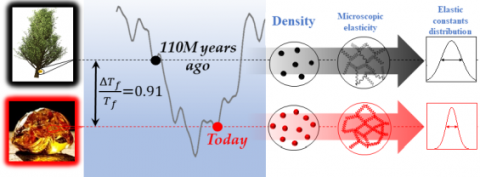Stepping back 110 million years in time to study the signs of aging on materials elasticity

An international team of researchers, directed by Tullio Scopigno from “Sapienza” Department of Physics, has revealed the effects of ageing on the elastic properties of resins by using an ancient amber fossil found in the recently discovered deposit at El Soplao in Cantabria (Spain). Amorphous materials such as amber (resins, polymers, glass and ceramics) are metastable, which means they experience an intermediate state between a liquid and a solid, and are subject to slow structural modifications upon evolving towards more stable configurations over millions of years. Understanding such “aging” processes is of fundamental importance in order to define the peculiar nature of amorphous systems which, as Scopigno explains: “are usually synthesized starting from the liquid state through a cooling process that avoids crystallization, namely the formation of a microscopically ordered solid. The typical disordered structure of a liquid is maintained, but with viscosity values pertaining to common solids.” This class of materials is extremely relevant from a technological point of view and is widely used in signals transmission (optic fibers), in micro-electronics, opto-electronics and photovoltaics applications (amorphous silicon), as well as for the development of plastics and adhesives. However, to date, most of their the physical properties have not yet been fully understood and rationalized as part of an accepted theoretical model. The direct observation of the evolution of glass properties, in fact, presents a significant achievement: it takes place on extremely long time scale, which are inaccessible to experimental observations. Thus, studies on aging are normally restricted to theoretical or computational methods. In order to experimentally observe the effects of aging on the properties of an amorphous system after a geological span of millions of years, the researchers exposed the amber to a specific thermal treatment. It was heated for a certain time above the glass transition temperature and then cooled to room temperature undergoing the conventional vitrification process. This procedure allowed researchers to bring the fossil back to the state it was when the process first began, a sort of thermal “lifting” to erase the traces of time and rejuvenate the fossil by 110 million years. “Comparing the properties of the vitreous amber before and after the thermal treatment that rejuvenated the material, bringing it back to its original state of 110 million years ago,” explains Eva Pogna, first author of the paper, “allowed us to relate for the first time the disorder level in an amorphous material to its age, revealing how its elastic properties evolved during the stabilization process.” The study is the outcome of an international collaboration among Sapienza University of Rome, the European Synchrotron Radiation Facility in Grenoble, the National Research Council and the Italian Institute of Technology.
Reference:
